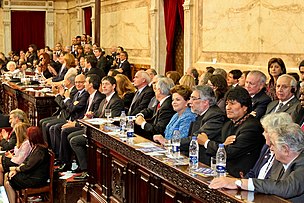State feminism
The term was coined by Helga Hernes with particular reference to the situation in Norway, which had a tradition of government-supported liberal feminism dating back to the 1880s, and is often used when discussing the government-supported gender equality policies of the Nordic countries, that are linked to the Nordic model.
[1][2] The term has also been used in the context of developing countries where the government may prescribe its form of feminism and at the same time prohibit non-governmental organizations from advocating for any other feminist program.
[4] Scholars of state feminism look at the effectiveness of various government programs, and how they improve women's rights and their status in their localities.
[4] Feminist theorists in the 1980s had begun to reconsider the role that governments could have on positive outcomes for women's lives.
[9] Hernes noted that liberal welfare policies combined with high levels of women representation within legislative bodies were defining characteristics of each of these states.
[10] The RNGS looked to clarify the idea of state feminism, initially defined as "when women’s policy agencies acting as allies of women’s movement actors achieve policy goals and procedural access to policy-making arenas".
[14] To define the meso level they use Threlfall's description of state feminism, "result of the interplay between agitation from below and integration policy from above".
[18] The state feminism they followed, according to scholar Margot Badran, covered parts of patriarchy with an appearance of Western progressivity.
"[22] "Northern women had acquired an acute gender consciousness and developed practical feminist skills ... but they had no legitimate political space.
[23] Norway has a tradition of government-supported liberal feminism since 1884, when the Norwegian Association for Women's Rights (NKF) was founded with the support of the progressive establishment within the then-dominant governing Liberal Party (which received 63.4% of the votes in the election the following year); the association's founders included five Norwegian prime ministers and several of its early leaders were married to prime ministers.
"[26] Sweden also has the Gender Equality council which consists of "representatives from the women’s movement... political parties, NGOs and the social partners" and meets with the minister 4 times a year.
[14] This relationship has created an expectation from women's movements that the Welfare state will bring out "public measures for gender equality".
WRCs receive public funding to balance out the gender representation of regional development policy.
[26] A change was made in 1994 which removed the collective agreements exclusion and forced all workplaces over 10 workers to have a gender equality plan.
[26] In the 1980s and 1990s, "feminist activists and scholars in the Middle East assailed the limits of 'state feminism' and exposed its patriarchal dimensions.
"[27] "Sharon Wesoky characterized the relationship of an emergent women's movement to the [Chinese] state as 'symbiotic,' containing elements of both autonomy and dependence, and operating largely within rather than in opposition to party-state institutions.
[30] This policy constructed a comprehensive state ran child care program that consequently led to an unprecedented 78 percent employment rate for women [31] The countries centralized government has been attributed to a major reason as to why feminists were able to successfully implement policy [32] Additionally, higher government funding allowed for more ensured success for social programs before reunification.
[11] Along with this, a shift of power towards non-elected officials and NGOs meant other actors were now working with along the state to form policy.
[11] Professionalization consists of forming NGOs and funding gender experts to create their own sources of policy agencies.
Kantola and Squires offer a more modern term, "market feminism", which performs similarly but requires that the relationship between "agencies and the movement with the state" be distinctly different in such that they have "specific strategies, funding, and discourses that rely on market ideas and practices.


